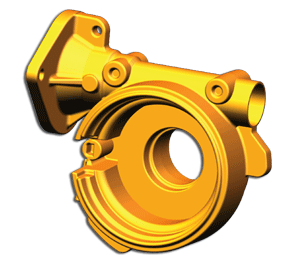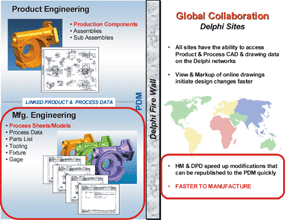Latest News
December 1, 2004
By Diane Landers, Brad Muscott, Kevin Marseilles, Pravin Khurana, and Christopher Charlebois
This is the final installment in a series of articles about how new methodologiesoffer benefits over technology-based innovation. In last month’s issue (DE, December2004), Gary Patelski and Jeffrey Solash outlined how a change in design methodsleads to improved CAD/CAM on-time performance.
CAD software vendors often tell prospective customers how using their productswill make product and process design and engineering easier. While design softwareoffers obvious advantages over pencil and paper, many problems outside of thedesign realm still exist.
Product designers will typically be handed a project without full knowledge ofa part’s or component’s intent. “We’ll add that later, don’t worry,” they’re told.As a result, they must be prepared to alter their models at a later date. Onthe other hand, process designers will frequently begin designing a manufacturingprocess without finalized product designs or a designated manufacturing location.On top of that, if they work at a global company, their process must account forchanges in equipment and ergonomic guidelines from country to country, which effectivelychanges the process. And while engineering often does not need fully parametric
models, its purveyors must realize that design changes suggested by their analysestypically require lots of time to implement. All these demands (and those discussedin the October 2004 and December 2004 installments in Desktop Engineering) placea premium on the ability to make rapid, accurate changes to both product and processmodels.

A team of engineers at Delphi Corporation (Troy, Michigan), a developer of automotivesystems, has developed new design methodologies to make these changes more efficient.These new methods, which do not require new computer code, were developed andproven at Delphi’s Saginaw Steering division. They enable simple changes to CAD/CAMproduct and process models and have been used in the design of more than 66,000parts over the last several years.
Moving Horizontally, Not Vertically

The basic problems illustrated above all involve the use of traditional modelingmethods where features are placed and positioned to other features. This method,currently suggested by most vendors, preserves a model’s characteristics by creatingso-called parent-child relationships (or vertical feature trees). If a designercreates a “perfect” model (one that never requires altering, editing, or changing),then this method rigidly preserves design intent. However, feature trees do notallow for easy alteration of the model, and changes always occur.
By using Horizontal Modeling (HM) methodologies, Delphi engineers now place andposition features relative to datum planes, and not to other features. Since mostdesign software enables the use of datum planes, HM can be implemented by usersof most platforms.
While HM seems simple in principle, Delphi has developed a formalized approachto using it that forms the basis of its standard methods. In concept, HM’s approachto CAD modeling is analogous to applying statistical principles (e.g., Six Sigma)to business problems.
The basic method involves the primary use of coordinate planes. Features arethen placed and positioned in relationship to a set of datums (the World CoordinateSystem, to use Unigraphics terminology). In this way, features rely on datums,not on other features. Eliminating, altering, or changing particular feature parametersdoes not affect other features (minimizing parent-child relationships) and allowsthe model to update problem-free. If desired, using parametric relationships betweenfeatures and datum planes can capture associativity between features. Designerswill realize that certain kinds of features, such as chamfers and blends, mustalways be attached to other features, and HM is flexible to easily accommodatethis type of relationship. Legacy data, which is a very important aspect of anyCAD/CAM database, can easily be converted to the HM format and Delphi has developedstandard approaches to accomplish this.

Digital Process Design (DPD)
The use of HM also forms the enabling basis of Digital Process Design (DPD),a second methodology that has helped Delphi save time and money.
In traditional 2D or even 3D methods, process documentation is not associatedclosely to individual in-process models. For example, a traditional method usedin the CATIA v.5 platform enables typical linkages created for process sheetsto be reflected in a single view in all in-process sheets when the process modelgets altered. This condition requires a process designer to individually updateall process sheets to correctly reflect the altered model views. This extra timeand effort, which added no value to the project, often led to errors and alwaysresulted in reduced competitiveness. DPD changes this dynamic.
In DPD, Delphi associates (yes, in a parent-child relationship) process documentationusing individual in-process models. In this way, when model changes are implemented,the in-process models are automatically updated. This automatic update in HM isimportant, since process documentation is electronically linked to in-processmodels. HM eliminates errors due to redesign of the product model and recreationof that product model in process documentation. Delphi Steering has documentedsavings of up to 90 percent in time spent editing that documentation.
Delphi Steering often makes the same part in factories located around the world.By using DPD, each factory is enabled to make rapid alterations of a design toaccommodate its specific capabilities. Previously this meant each factory hadto create a separate process design. Prior to HM, many of Delphi’s factories hadseparate process design departments, but since implementing HM at all Delphi Steeringplants, many have consolidated design groups. In essence, process designers havevastly increased their personal productivity.
The Road Ahead
Delphi continues to develop manufacturing tools to increase productivity. Forinstance, it has developed a virtual toolpath method for determining the optimumpath of machine tools. This has meant better optimization of the manufacturingprocess, and often results in process design changes, which are completed usingHM and DPD. In fact, HM and DPD enhance the use of many manufacturing tools underdevelopment or in advanced testing.
Because it’s virtually impossible to design a product perfectly the first time,last-minute changes to product and process demanded by OEM customers will occur.Accommodating the changes demanded by both manufacturing stakeholders and consumersis key. And, since we cannot stop change, we need to embrace it and find a wayto create flexible product and process models like those enabled by Delphi’s DesignMethodologies.
Pravin Khurana is a staff manufacturing engineer for the Delphi Dynamics andPropulsion Innovation Center. Diane Landers is a manufacturing systems analyst,Brad Muscott is the global process sheet coordinator, Kevin Marseilles is an advancedmanufacturing designer, and Christopher Charlebois is a senior manufacturing engineerfor Delphi Steering. Delphi Design Methodologies are available to other discretemanufacturers through special training and certification programs. Send commentson this article c/o [email protected].
Product and Company Information
Delphi Corp.
Troy, MI
delphi.com
Subscribe to our FREE magazine, FREE email newsletters or both!
Latest News
About the Author
DE’s editors contribute news and new product announcements to Digital Engineering.
Press releases may be sent to them via [email protected].






